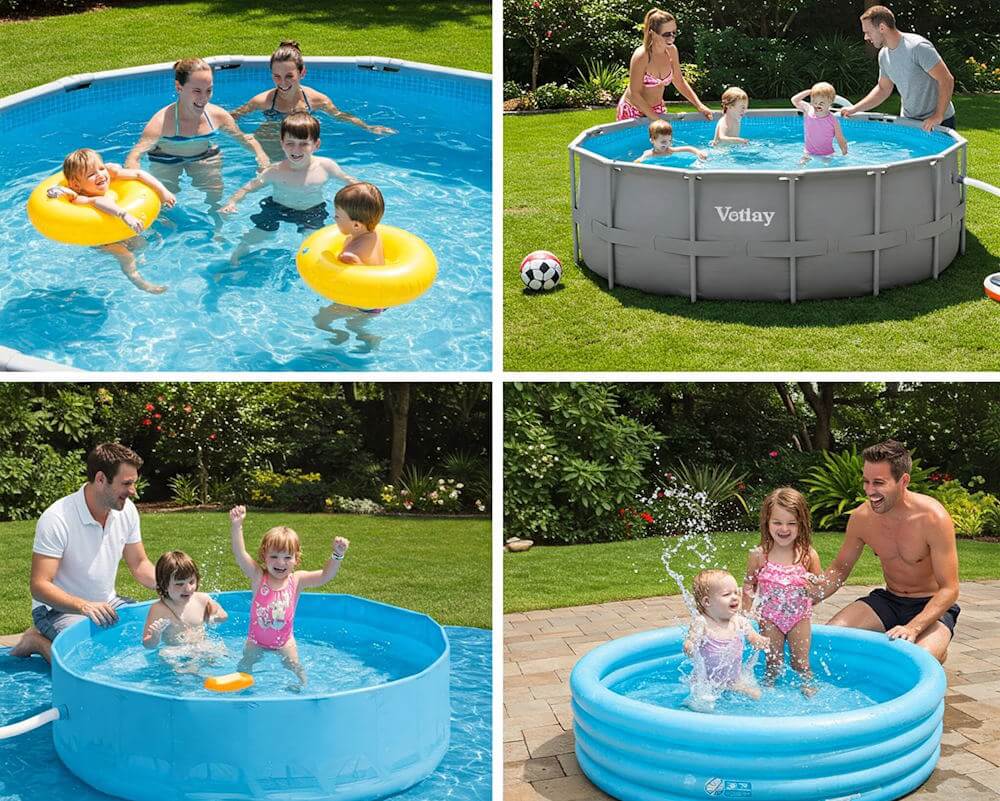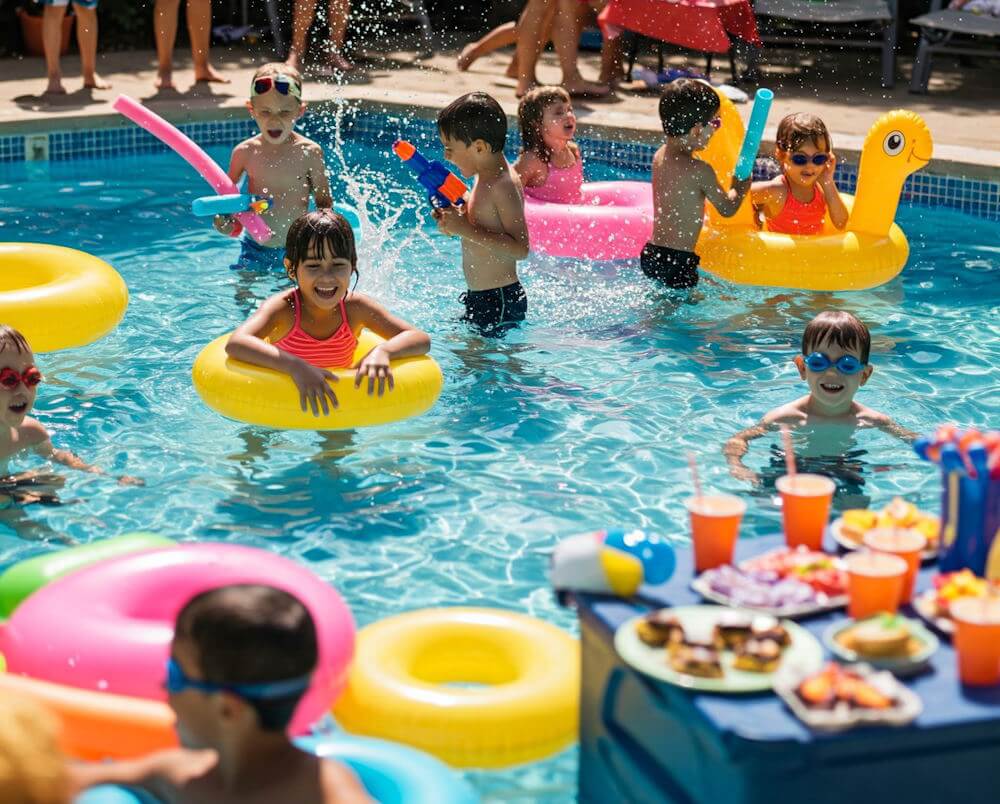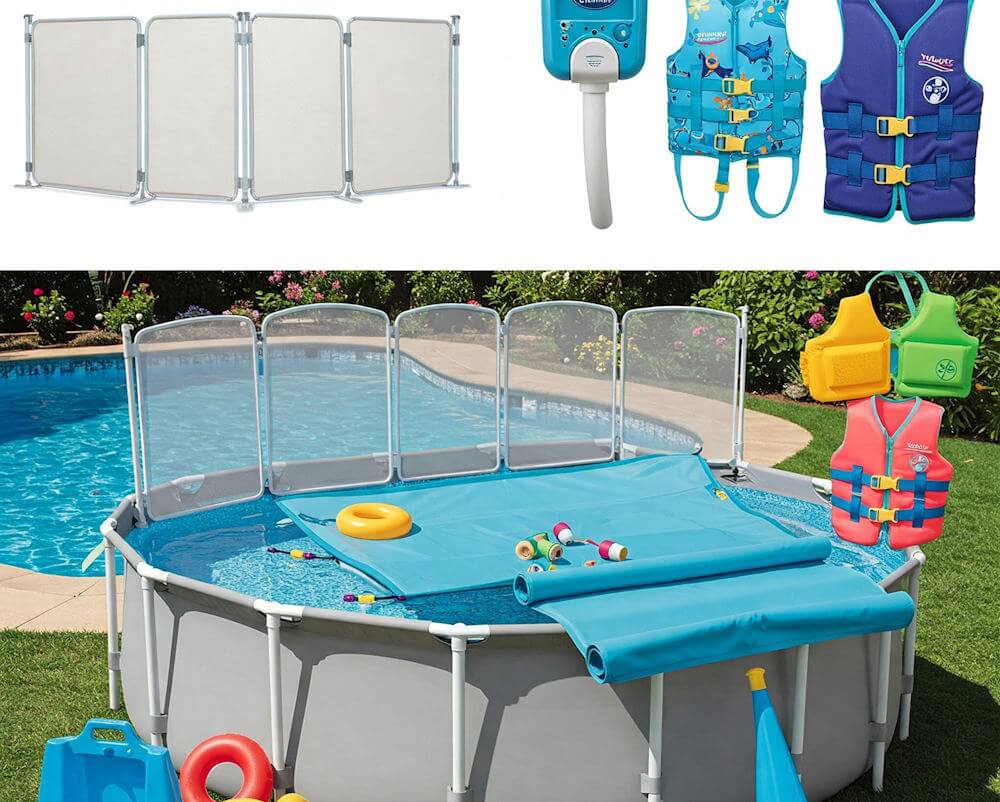As families look for ways to create enjoyable summer experiences without overwhelming their finances, budget-friendly pools have emerged as a popular solution. These pools offer an opportunity for families to indulge in leisure and recreational activities while staying within budget. The warm months often spark a desire for outdoor fun, and having a pool can transform any backyard into a personal paradise. This transformation can lead to memorable family moments and substantial savings compared to frequent outings to public swimming facilities.
Budget-friendly pools come in various shapes and sizes, enabling families to select options that align with both their financial constraints and space availability. Whether opting for an inflatable pool, a compact above-ground model, or an innovative DIY solution, the affordability of these alternatives allows families to enjoy the benefits of swimming without incurring substantial costs. Furthermore, a pool can serve as a gathering spot for family and friends, promoting bonding and quality time together while enjoying the sunshine.
Beyond the enjoyment it provides, having a pool at home is a strategic way to stay cool during the sweltering heat of summer. It promotes an active lifestyle, encourages children to engage in physical activities, and helps in developing essential swimming skills. Additionally, a home pool can enhance the property’s value when maintained properly, making it a worthwhile investment in the long run. As we explore various types of budget-friendly pools in the upcoming sections, it is important to recognize the myriad advantages they offer to families seeking an enjoyable summer experience without breaking the bank.
Types of Affordable Pools
When considering the perfect pool for a family, affordability often takes precedence. Fortunately, several types of budget-friendly pools cater to diverse family needs and preferences. Each option boasts unique features, maintenance requirements, and cost structures that families should evaluate before making a decision.
First, above-ground pools are among the most popular options for families seeking an affordable pool solution. Typically constructed from materials such as steel, aluminum, or resin, these pools can vary significantly in terms of size and design. The installation process is generally straightforward, making it an appealing choice for families new to pool ownership. With prices ranging from a few hundred to several thousand dollars, above-ground pools often provide a more economical alternative to in-ground pools. Their maintenance involves regular cleaning and water testing, yet many families find the effort manageable.
Another excellent option is inflatable pools. These pools have gained popularity due to their ease of setup and low cost. Made from durable vinyl or other similar materials, inflatable pools are available in various shapes and sizes, typically priced from $50 to a few hundred dollars. Such pools are ideal for families with limited space or budget constraints, as they can easily be deflated and stored when not in use. However, their lifespan is generally shorter than that of above-ground pools, and they may require more frequent upkeep due to the potential for punctures or leaks.
Lastly, natural swimming pools stand out as an environmentally friendly alternative and can be tailored to suit a family’s preferences. Although the initial setup cost may be higher compared to other options, they offer low maintenance costs in the long term and a unique, aesthetic appeal. Natural pools utilize plants and biofiltration systems to maintain cleanliness, eliminating the need for chemicals typically found in conventional pools. Families interested in eco-conscious lifestyles often find these pools to be a fitting choice.
Ultimately, the ideal affordable pool option will depend on individual family needs, preferences, and budget constraints. Evaluating the features and maintenance requirements of each type can help families make informed decisions on their pool investments.
DIY Pool Ideas that Save Money
Creating a family-friendly pool at home can often feel financially daunting, but there are numerous DIY pool ideas that can help families save money while bringing the joys of water play right to their backyards. Whether you prefer the simplicity of a plunge pool or the spirited nature of a splash pad, a variety of options exist for budget-conscious families willing to roll up their sleeves.
One of the most straightforward DIY options is constructing a simple plunge pool. This type of pool requires minimal materials and can fit into a smaller backyard space. Start by outlining the desired shape of the pool using string or stakes. Next, dig a hole to the appropriate depth, ensuring the sides are firmly packed to prevent collapse. Using affordable materials like pool liners and simple filtration systems, families can create an effective plunge pool for under a couple hundred dollars. Adding landscaping features or deck chairs around the pool can create a relaxing atmosphere, further enhancing the experience.
Alternatively, a backyard splash pad provides an excellent way for children to enjoy water play without the need for extensive construction. This can be easily set up using household materials such as a tarp or large plastic sheet. By pitching it on a slight incline, you can create a water runoff that the children can play in. For added fun, incorporate sprinklers or water jets activated by a simple hose connection. The materials needed for this project are often readily available, making it a very cost-effective solution for summer fun.
To minimize costs while creating these DIY pool options, families should consider utilizing recycled materials whenever possible. For example, old tires can serve as decorative accents around a plunge pool, while used containers can be repurposed as water features in a splash pad. By creatively reimagining existing materials, families will not only save money but also contribute to environmental sustainability.
Choosing the Right Location
When it comes to selecting the ideal location for a family pool, several essential factors must be considered to ensure both enjoyment and safety. Understanding the importance of sunlight exposure is paramount; ideally, the pool should receive ample sunlight throughout the day. This not only keeps the water at a pleasant temperature but also promotes a comfortable swimming experience for family members. Positioning the pool in an area that captures sunlight while also considering shade from surrounding trees can strike a balance that enhances usability.
Accessibility is another critical factor in determining the pool’s location. The pool should be easily reachable from the home, allowing family members to transition smoothly from indoors to the poolside. Proximity to changing areas, restrooms, and outdoor seating can facilitate a more pleasant swimming experience. Furthermore, considering the layout of your yard to minimize obstacles and creating safe pathways can enhance safety for children and visitors.
Speaking of safety, it’s vital to adhere to any safety regulations that apply to pool installation. Familiarizing oneself with local laws regarding setbacks and fencing requirements can prevent potential legal issues down the line. In some regions, zoning laws may dictate the permissible location and type of pool that can be installed. This can vary significantly depending on municipal regulations, so consulting with local authorities can provide clarity on necessary permits and compliance measures.
Lastly, considering the proximity of the pool to other outdoor amenities can complement your family’s recreational needs. For example, positioning the pool near a patio or outdoor kitchen can create an appealing social atmosphere for gatherings. Overall, carefully assessing these crucial factors will pave the way for a more enjoyable and safe family pool, ensuring that it becomes a cherished feature of your yard.
Maintenance Tips for Low-Cost Pools
Maintaining a budget-friendly pool is essential for ensuring its longevity and cleanliness while minimizing costs. Regular upkeep not only extends the pool’s lifespan but also enhances the swimming experience for families. One of the primary aspects of pool maintenance is routine cleaning. Skimming the surface to remove debris, such as leaves and insects, should be conducted daily, while brushing the walls and floor can be done weekly. This prevents dirt accumulation and algae growth, which can be more difficult and costly to eliminate if left unattended.
Another critical element is water testing. Investing in a good pool test kit can help you monitor the chemical levels in the water, ensuring it stays balanced. This balance is vital for the comfort and safety of pool users. The pH, chlorine, and alkalinity levels should be checked regularly—ideally once a week. Maintaining proper chemical balance prevents skin irritation and promotes a healthy swimming environment. It reduces the need for excessive chemical treatments, thereby saving costs in the long run.
Affordable equipment options can significantly aid in ongoing maintenance. Automatic pool cleaners, while initially more costly, can reduce the time spent cleaning manually and lower water wastage. Additionally, using a pool cover can minimize debris, reducing the frequency of cleaning required. While searching for budget-friendly solutions, consider second-hand equipment or sales at local retailers. These approaches can help cut costs without sacrificing quality.
By implementing these maintenance strategies, families can enjoy a well-maintained pool environment that remains cost-effective and enjoyable for years to come.
Safety Measures for Family Pools
Ensuring a safe swimming environment is vital for families with budget-friendly pools. The presence of water brings inherent risks, particularly with young children. One of the most critical safety measures to implement is adequate fencing around the pool area. According to safety regulations, a fence should be at least four feet high, with self-closing and self-latching gates that are positioned out of the reach of children. This barrier creates an essential protective perimeter, significantly reducing the chance of accidental drownings.
In addition to fencing, pool covers serve as another effective safety measure. Utilizing a safety cover can protect the pool when it is not in use. These covers are designed to support the weight of a child, ensuring that they cannot accidentally fall into the water when the pool is covered. Many pool covers can be easily installed and removed, making them a convenient option for parents seeking to enhance safety measures without incurring high costs.
Furthermore, constant supervision is paramount when children are in or around the pool. Adult supervision should be present at all times, as drowning incidents can occur in mere seconds. Designating a responsible adult as the “water watcher” can help maintain this vigilance. It is also recommended that parents educate their children about pool safety, including rules such as no running or rough play around the pool edge.
Installing safety features such as pool alarms can further secure the pool environment. These alarms can alert parents or caregivers when someone enters the pool area unexpectedly. Investing in these safety measures may contribute to peace of mind, enabling families to enjoy their budget-friendly pools responsibly and safely. With these precautions in place, families can significantly mitigate risks and create a secure setting for unforgettable summer memories.
Alternative Pool Options for Limited Space
For families with limited outdoor space, traditional in-ground pools may not be a viable option. Fortunately, there are several alternative pool solutions that not only maximize space but also enhance recreational opportunities. Two popular alternatives include swim spas and lap pools, both designed to fit into smaller areas while providing functionality and enjoyment for the entire family.
Swim spas offer the unique advantage of combining a swimming pool and a hot tub into one compact unit. These versatile pools allow for continuous swimming against a current, making them an excellent choice for exercise enthusiasts. Additionally, swim spas typically require less maintenance compared to larger pools, and they are energy-efficient due to their smaller size. However, potential buyers should consider the initial investment, as the cost of swim spas can be relatively high. Furthermore, while they provide an excellent swimming experience, swim spas may not accommodate larger groups at once, which could limit family gatherings.
Lap pools are another effective space-saving option. Typically long and narrow, they are designed primarily for swimming laps and can fit conveniently in narrow backyards. One of the greatest benefits of a lap pool is its ability to promote regular exercise without occupying a large footprint. These pools can be equipped with jet systems to allow homeowners to swim against a current, creating a dynamic workout environment. On the other hand, lap pools may sacrifice the shallow area often preferred for leisure activities and relaxation, making them less ideal for families with younger children who enjoy splashing around.
Ultimately, selecting between swim spas and lap pools depends on the family’s specific needs and available space. By weighing the pros and cons of each option, families can make informed decisions that align with their lifestyle and budgetary constraints without compromising on fun and fitness.
Budget Considerations and Hidden Costs
When contemplating the addition of a pool to your family home, it’s vital to evaluate not only the upfront costs but also the ongoing expenses associated with pool ownership. The initial installation can range significantly based on the type of pool selected, with options including above-ground models, in-ground installations, and more extravagant designs. Families should take into account the costs associated with site preparation, excavation, and the purchase of necessary equipment such as pumps, filters, and heaters.
Additionally, it is essential to factor in the long-term costs that accompany pool ownership. Regular maintenance is an ongoing obligation that includes chemical balancing, cleaning, and inspections. These maintenance costs can accumulate over time and may require a monthly budget allocation. Homeowners should not overlook the necessity for tools and supplies, as investing in quality products can influence the overall maintenance expenditure.
Furthermore, utilities play a significant role in the budget for pool owners. Increased water usage for filling and maintaining proper water levels, along with heightened electricity bills from heating and filtration systems, can substantially impact monthly costs. Insurance considerations should also be evaluated, as owning a pool may necessitate higher premiums or additional liability coverage.
Moreover, it is advisable to consider potential hidden costs that might arise, such as repairs due to wear and tear or damage caused by harsh weather. Families may also want to think ahead about the possibility of hiring professionals for extensive maintenance or renovation tasks, which would further increase overall expenses.
By diligently calculating both the visible costs and hidden expenses associated with pool ownership, families can establish a more comprehensive and realistic budget. This planning enables families to make an informed decision that aligns with their financial situation, ensuring a smooth transition into pool ownership that does not compromise their overall financial stability.
Conclusion: Making a Splash on a Budget
In reviewing the various budget-friendly pool options available for families, it becomes evident that creating an enjoyable swimming space does not necessarily have to lead to financial strain. The key lies in careful planning and consideration of multiple factors, which can significantly influence the overall cost of pool ownership. Families can explore a range of choices, from above-ground pools to inflatable options, which often require less investment and allow for flexibility based on space availability and personal preferences.
Moreover, DIY installation and maintenance tips showcased throughout this guide can empower families to take control of their pool experience while maximizing value. Learning to perform routine upkeep can save money in the long run and enhance the longevity of the pool. Additionally, considering energy-efficient models and eco-friendly alternatives can lead to reduced operational costs, further easing the financial burden.
Throughout this journey towards a budget-friendly pool, engaging with community resources and online forums can provide valuable insight into best practices and shared experiences. Families are encouraged to reach out and share their own pool stories, whether it be challenges faced or tips discovered along the way. Such interactions not only foster a supportive community but could provide inspiration to others seeking to make a splash while adhering to financial constraints.
Ultimately, the dream of enjoying a refreshing pool experience is within reach for families who are willing to explore their options and take actionable steps. With the right strategy and a creative approach, the journey to establishing a pool that aligns with their budget can lead to lasting memories for years to come. Therefore, families are invited to embark on this thrilling adventure, transforming any backyard into a cherished recreational haven.



